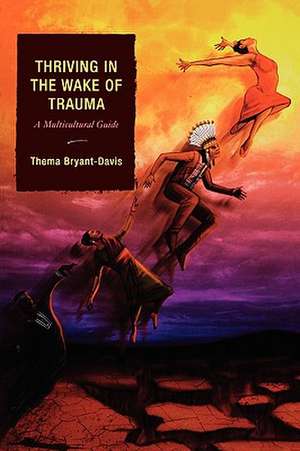Thriving in the Wake of Trauma
Autor Thema Bryant-Davisen Limba Engleză Paperback – 7 feb 2008
| Toate formatele și edițiile | Preț | Express |
|---|---|---|
| Paperback (1) | 374.07 lei 6-8 săpt. | |
| Rowman & Littlefield – 7 feb 2008 | 374.07 lei 6-8 săpt. | |
| Hardback (1) | 308.13 lei 6-8 săpt. | |
| Bloomsbury Publishing – 29 iun 2005 | 308.13 lei 6-8 săpt. |
Preț: 374.07 lei
Nou
Puncte Express: 561
Preț estimativ în valută:
71.57€ • 74.74$ • 59.11£
71.57€ • 74.74$ • 59.11£
Carte tipărită la comandă
Livrare economică 16-30 aprilie
Preluare comenzi: 021 569.72.76
Specificații
ISBN-13: 9780759111714
ISBN-10: 0759111715
Pagini: 204
Dimensiuni: 154 x 227 x 13 mm
Greutate: 0.35 kg
Editura: Rowman & Littlefield
ISBN-10: 0759111715
Pagini: 204
Dimensiuni: 154 x 227 x 13 mm
Greutate: 0.35 kg
Editura: Rowman & Littlefield
Notă biografică
By Thema Bryant-Davis
Descriere scurtă
Cuprins
Series ForewordPrefaceAcknowledgmentsIntroductionSafetySelf CareTrustShame and Self BlameMemoriesMourning and LossesAngerBody ImageSexualityCoping StrategiesThrivingAfterwordReferences
Recenzii
Bryant-Davis is an internationally renowned expert on trauma, so it is no surprise that this is the single most powerful book on trauma in recent history. The author argues that cultural context provides the most salient information about everyone, and particularly those who have experienced trauma. This context includes a wide variety of considerations, from predictable variables such as gender, socioeconomic status, race, and religion to variables less studied and/or understood--e.g., sexual orientation, disability, and migration status. The complexity of both the culture and the trauma (physical, sexual, emotional, etc.) make the recovery a multifaceted journey. Bryant-Davis defines thriving as the post-trauma growth that the survivor may experience as a result of making healthy choices during recovery, and perhaps the most useful contribution of this volume is the road map the author provides for thriving. For instance, she encourages journaling, arts and crafts, movement, drama, music, nature, and social support as creative paths to developing trust, coping strategies, healthy sexuality, and means of thriving. Offering excellent tools that can realistically provide a therapeutic springboard for healing, this book is a valuable addition to literature on trauma. Essential. Upper-division undergraduate, graduate, research, and professional collections.
Bryant-Davis provides tools for both practitioner and survivor as well as case-examples for each theme of recovery, which illustrate the intersection of cultural and the particular theme of recovery being addressed. Thriving in the Wake of Trauma will enrich practice, teaching, and the recovery process.
Bryant-Davis's book is a blend of scholarly review, self-help guide, case study and creative writing. She includes not just traditions and identity based on ethnicity and race, but disability, gender, migration status, religion, religion, sexual orientation, and socioeconomic status as well. Interpersonal trauma is defined as any violition against a person or group of people that leads to feelings of powerlessness and emotional, cognitive, physical and spiritual wounds. An important contibution of Bryant-Davis is her emphasis on thriving after trauma, in contrast with recovery from trauma. To thrive, survivors work to move beyond symptom reduction to attain empowerment, awareness of one's strengths, and hopefully a level of functioning greater than before the trauma.
In this groundbreaking book, which integrates cultural concepts with recovery from trauma, each of the 11 chapters explores the themes of safety, self-care, trust, shame and self-blame, memories, mourning the losses, anger, body image, sexuality, coping strategies, and thriving. The author explores both theoretical and empirically based concepts related to the cultural context of recovery..Bryant-Davis poignantly states in her preface that she wrote this book for diverse audiences - for survivors and those in recovery, therapists, ministers, researchers, doctors, nurses, police officers, judges, government officials, advocates, volunteers, and students - and as a source and a place for healing in which all are welcome to come. She has admirably succeeded in her purpose and has penned a book that is indeed a refreshing, remarkable, and relevant resource for all of its diverse audiences.
Bryant-Davis provides tools for both practitioner and survivor as well as case-examples for each theme of recovery, which illustrate the intersection of cultural and the particular theme of recovery being addressed. Thriving in the Wake of Trauma will enrich practice, teaching, and the recovery process.
Bryant-Davis's book is a blend of scholarly review, self-help guide, case study and creative writing. She includes not just traditions and identity based on ethnicity and race, but disability, gender, migration status, religion, religion, sexual orientation, and socioeconomic status as well. Interpersonal trauma is defined as any violition against a person or group of people that leads to feelings of powerlessness and emotional, cognitive, physical and spiritual wounds. An important contibution of Bryant-Davis is her emphasis on thriving after trauma, in contrast with recovery from trauma. To thrive, survivors work to move beyond symptom reduction to attain empowerment, awareness of one's strengths, and hopefully a level of functioning greater than before the trauma.
In this groundbreaking book, which integrates cultural concepts with recovery from trauma, each of the 11 chapters explores the themes of safety, self-care, trust, shame and self-blame, memories, mourning the losses, anger, body image, sexuality, coping strategies, and thriving. The author explores both theoretical and empirically based concepts related to the cultural context of recovery..Bryant-Davis poignantly states in her preface that she wrote this book for diverse audiences - for survivors and those in recovery, therapists, ministers, researchers, doctors, nurses, police officers, judges, government officials, advocates, volunteers, and students - and as a source and a place for healing in which all are welcome to come. She has admirably succeeded in her purpose and has penned a book that is indeed a refreshing, remarkable, and relevant resource for all of its diverse audiences.















